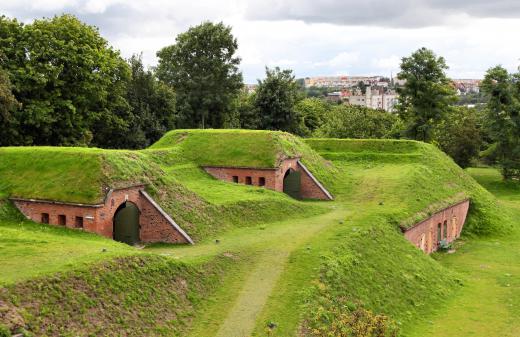What is a Berm?
 Mary McMahon
Mary McMahon
A berm is a naturally occurring or man-made mound of earth, often found near bodies of water. Berms are among the oldest constructions made by man and have been used for centuries to contain areas, bolster defenses, aid in home construction, provide privacy, and add variation to a landscape. The term is also used to refer to the flattened area of a beach slightly above the tide line created by repeated sediment deposits from storm waves. The word is of Dutch origin, and is one of many Dutch words used to discuss barriers in the natural landscape.
A basic berm can be created simply by mounding soil, and is almost always found in close proximity to a trench or another dug out area. In this case, the gently sloping earth helps to prevent erosion, a common problem, especially with deep trenches. This type is common in defense engineering constructions, because it is difficult to advance over the construction, and soldiers can use the mound to provide defensive cover. In military terms, this is also sometimes called an earthwork, and archaeological evidence of ancient military earthworks has been found in many parts of the world. Many road construction crews also create berms of this type, which helps to serve as a sound baffle for neighboring homes, while excavating land for a new road.

More complex ones have a sturdy substrate made out of rocks or gravel, topped by clay and finally packed with soil. This type of more permanent berm is often used to contain floodwaters, provide a barrier between land belonging to different people, or to keep livestock confined. When well maintained, they can last for centuries and have a profound shaping impact on the landscape that they are constructed in. In some instances, the mound is so old that it is not readily recognizable as a human construction, and may be confused with part of the natural landscape.

In landscaping and architecture, many green designers use berms extensively. Because they have a natural look and feel to them, they can help insulate a home from noise and wind without being obtrusive, like a fence. The berm itself can be landscaped with grasses and trees to give it a more natural look and feel. Some green designers will actually surround a home with such earthworks to blend it in with the environment while providing insulation from wind and preventing heat loss from the home. This also reduces the ecological footprint of the home, because it requires less resources to heat and cool. A classic example of a bermed home is the hobbit holes seen in the Lord of the Rings, which appear to blend naturally into the hillsides around them.
AS FEATURED ON:
AS FEATURED ON:














Discussion Comments
does anyone know what the general rule is on how far a man-made natural soil berm has to be from a residential property line?
Berm is also the word used to describe the banked turns on dirt tracks for off-road vehicle racing such as Moto-Cross and BMX racing. Also, anyone who lives in snow country knows about the wall of snow left by passing plows that pile up much higher than the actual snow depth, especially across the top of your freshly shoveled driveway!
According to Wikipedia, in Pennsylvania, Ohio, Indiana, and West Virginia the word "berm" refers to the shoulder of a highway.
Post your comments